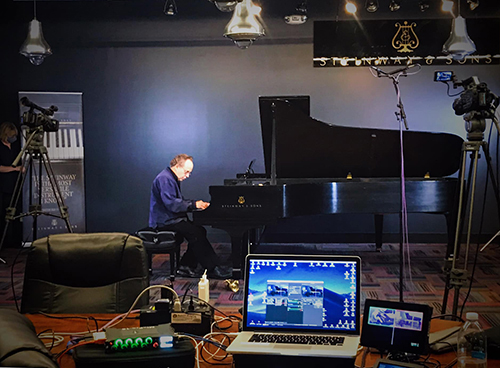by Daniel Hathaway

The first program was recorded at the Steinway Piano Galleries (pictured) for broadcast on Hudson’s Music From the Western Reserve series on September 13. The final episode, to be live streamed from CIM’s Kulas Hall, includes Opus 109, 110, and 111.
This marks the third time that Shapiro has tackled all 32 of Beethoven sonatas, initially all in the course of a single month, but in the last two cycles, spread over a whole academic year.
Having previewed the series in the fall, I telephoned Daniel Shapiro to ask what he was thinking and feeling after playing seven concerts.
“This time I realized how much I’ve changed, and how much the pieces have changed — what I’ve learned and how much there still is to learn. And how damned hard they are to play!”
Shapiro added that COVID-19 completely changed the context in 2020-2021. “These performances couldn’t be done in front of a live audience, which isn’t as much fun, because you don’t get that immediacy of feedback. But even if there are two or three people in the room, it makes a huge difference.”
Performing the sonatas in this format must be a weighty experience, I suggested. Shapiro agreed. “They present enormous technical challenges for the pianist — and I’m not talking merely about the difficult passages, of which there are plenty, but just the complex and very fine technical demands. They’re significant works, and you can practice the heck out of any one of them, but there’s no guarantee that everything will work perfectly in performance.”
Nevertheless, Shapiro doesn’t make it easy on himself. “I don’t like to play it safe in performances,” he said. “I strive each time to play better than I’ve ever played in my life, musically speaking, so that involves a different kind of playing that isn’t as secure, you might say.”
Has his intimate relationship with the pieces allowed Shapiro to get inside Beethoven’s mind? (Scary thought!) “I hope I’ve gotten a little closer to what he might have been thinking.”
But that’s still elusive, Shapiro said. “All of the last three are like chasing the rainbow. You get close, then the rainbow recedes. And everything changes from day to day. The ‘Hammerklavier,’ Op. 106 poses every possible conundrum and challenge. Yet it has an awful lot of fun to it. It’s jubilant and fun to play — in a certain kind of perverse way.”
Wednesday’s concert will mark the first time that Shapiro has played the last three sonatas together in the same concert. “Serkin has done that. It must be an experience like playing Hamlet.” Or perhaps King Lear.
Even though he’s played to microphones and cameras rather than to live audiences this year, Shapiro said he’s received “a lot of nice comments” about the performances. For the final lap, he’s looking forward to having a small, live audience in Kulas. “A few people in the CIM bubble can attend on Wednesday.
Published on ClevelandClassical.com April 6, 2021
Click here for a printable copy of this article


